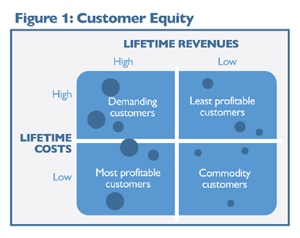In recent years there has been a growing focus on understanding the profitability of customers. Alarmingly, as companies learn more about the value of their relationship with their customers, they quite often also become aware that some customers are unprofitable. In hard times, companies need to think about the customers they acquire, and the way in which they manage and retain them, to make sure that they are getting the best possible return from each relationship.
To manage customers profitably, managers need to follow these three rules:
Rule 1. Understand the profitability of customers
Measuring the profitability of customers is more complex than measuring the profitability of products. The reason for this is that a customer’s relationship with a company may extend across a number of business units, so getting an overall picture of the whole relationship can be difficult. Unlike products, customers are not standardised. The cost of looking after each customer can vary from relationship to relationship.
There are three main ways in which companies can calculate the profitability of their customers. These are: customer profitability analysis; customer lifetime value; and customer equity. Customer profitability analysis usually refers to the value of a customer to the firm in the previous year. Customer lifetime value is the net present value of the future streams of profit (or cash flow) from a customer. Customer equity is usually used to describe the net present value of a customer portfolio.
When calculating customer profitability analysis, or forecasting customer lifetime value, the most important area to consider is Costs-To-Serve (CTS). The reasons that CTS are usually high are customer-specific. Some customers just need more management effort or ‘hand-holding’ than others. Typically, this is what makes the difference between a profitable and an unprofitable customer. CTS may include sales and account management costs, customer service, administration, and logistics costs. To measure CTS, the company needs to use an activity-based technique.
Activity-based costing is a precise and painstaking costing technique. However, a full activity-based costing exercise is not necessarily needed for customer profitability analysis. A good estimation of customer management costs can be obtained by analysing where account managers and sales people spend their time. Diary analysis can give this information, which is then multiplied by the costs of the manager or sales person involved. Some companies even have software systems that can record activity costs. Similar principles apply to calculating customer lifetime value, although this is a forecasting exercise. Customer-by-customer, the account manager has to forecast the products they will buy and the prices they will pay; and the costs to serve and direct costs in the future.
Where companies have hundreds or thousands of customers, a customer-by-customer calculation of lifetime value is impossible. In this situation, some organisations use a customer equity approach. A few key questions are used to establish the likely future revenues from a customer and estimate their costs (see figure 1 below).
The most valuable customers are, by definition, those that combine high lifetime revenues with low costs to serve. The least valuable are those with low revenues but higher costs. The customer equity concept will often incorporate estimates of products that customers may buy several years into the future. If the company is a bank or a mobile phone company with a sophisticated CRM system, it can use this to help it forecast the probable value of a customer.
Rule 2. Manage the customer portfolio for profit
If the value of a customer is known, the company is in a position to decide what offers it should make to that customer to maximise its chances of retaining them and capturing the lifetime value it has forecast. More importantly, understanding the value of customers enables decisions about when to say ‘no’ to customers. One of the big problems in trying to manage a customer portfolio profitably arises when sales people or account managers develop fabulous value propositions for their customers but fail to understand the cost of delivering them. This issue is exacerbated if sales people are rewarded on their top line sales, and not on the bottom line profits of those sales. In hard times, it is tempting to increase the incentives for customers to remain with the company. However, doing so could render them unprofitable if the company does not understand the cost implications of its retention strategies.
This raises the question ‘how much customer satisfaction is enough’? After all, some companies have worked hard to drive satisfaction levels up and up, only to find that customer retention is not following suit.
Research has shown that customers who declare themselves to be satisfied often still defect. Other studies have found that customer satisfaction levels are broadly in decline, even in places like the US where companies have been pumping lots of money into service. The sad truth is that a company will go bankrupt long before its customers are 100% satisfied.
In fact, there is a trade-off between creating shareholder value and delivering customer satisfaction. At lower levels of performance, the two are positively related. If you start from poor service and improve, customers will tend to stay longer, buy more and recommend you, which increases shareholder value. However, when customer service levels are high, further increases in service may actually cost the company money, because the rapidly-increasing costs of moving from good to great are higher than the incremental value gained from customers. In other words, companies can spend too much on looking after their customers. There’s no point having fantastically happy customers if the company is losing money on them.




